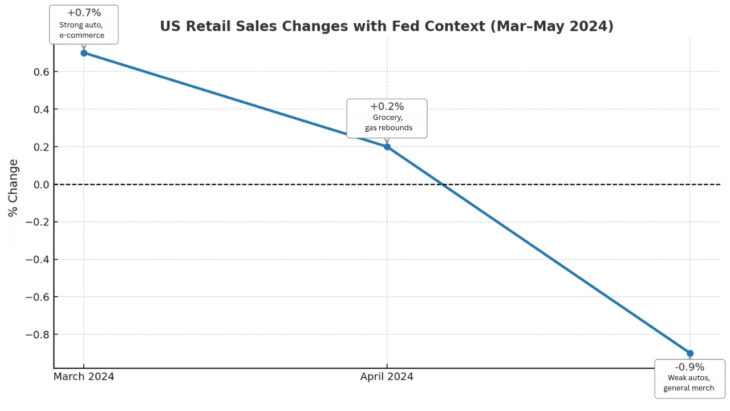US retail sales fell by 0.9% in the latest monthly reading, signaling the sharpest contraction since early 2023.
For swing traders, this marks a decisive short-term risk-off shift in consumer-facing stocks, especially as the Federal Reserve holds steady on rates and hints at “higher for longer” in its latest statement.
The fall suggests softening consumer demand just as markets priced in resilience, making volatility likely in the next 2–6 weeks.
The best setups are now on defensive names, oversold support bounces, and select short opportunities, while aggressive bullish trades in discretionary and cyclical sectors are high-risk until trend reversal signals confirm.
Table of Contents
ToggleUS Retail Sales: Recent Data

| Month | Retail Sales % Change (MoM) | Major Drivers | Fed Policy Context |
| March 2024 | +0.7% | Strong auto, e-commerce | Dovish, cuts expected |
| April 2024 | +0.2% | Grocery, gas rebounds | “Pause,” mixed signals |
| May 2024 | –0.9% | Weak autos, general merch | “Higher for longer” |
March 2024 (+0.7%)
Retail sales jumped, especially in autos and e-commerce. The Fed’s dovish stance fueled market gains, making this an ideal period for bullish trades in consumer and tech sectors.
April 2024 (+0.2%)
Growth slowed, with spending limited to essentials like groceries and gas. The Fed paused, and markets traded sideways – swing traders focused on short-term range strategies and avoided high-beta names.
May 2024 (–0.9%)
Sales dropped sharply across most categories. The Fed signaled no rate cuts, adding pressure to consumer stocks. Risk-off trades (defensives, shorts in retail/discretionary) worked best as volatility spiked.
Why This Matters for Swing Traders

Swing trading thrives on volatility and clear trend changes. Retail sales data is a real-time pulse of Main Street, moving major indices and sector ETFs. A –0.9% drop after Fed hawkishness means:
- Short-term momentum in retail, consumer discretionary, and small-caps turns negative.
- Defensive sectors (utilities, health care, staples) often outperform as traders rebalance risk.
- Technical levels are at risk of breakdowns (or false breakdowns), making stops and position sizing crucial.
Key Trading Implications Table
| Sector/ETF | Short-term Bias | Swing Opportunity | Key Risks |
| Consumer Discretionary (XLY) | Bearish | Short bounces only | Fast reversals, oversold |
| Retail (XRT) | Bearish | Fade weak rallies | News-driven squeezes |
| Utilities (XLU) | Bullish | Support holds/breakouts | Interest-rate sensitivity |
| Health Care (XLV) | Neutral/Bullish | Slow grind up | Sudden sector rotations |
| S&P 500 (SPY) | Volatile | Range trading | Macro headline risk |
What’s Driving the Drop? (Concrete Stats & Analysis)

1. Weak Consumer Demand:
The most recent government data shows personal consumption expenditures (PCE) growth slowing to 2.1% YoY, the lowest since 2021. Credit card balances hit a record $1.34 trillion (Federal Reserve Bank of New York, Q2 2025), and delinquency rates are creeping up. Households are tightening budgets after years of inflation and high borrowing costs.
2. High Interest Rates:
The Fed held the federal funds rate at 5.50% in June and signaled fewer cuts in 2025 than markets hoped. Mortgage rates remain above 7%, and auto loan rates have reached 8.2% on average, crimping big-ticket purchases.
3. Shifting Market Expectations:
Equities had been pricing in a “soft landing” scenario, but this retail sales miss challenges that narrative. Several large retailers, including Target and Best Buy, cut Q2 guidance last week, citing weaker store traffic and cautious shoppers. Visit here to learn more about this.
Technical Chart Levels to Watch
S&P Retail ETF (XRT)
- Support: $69.00 (multi-month base, now tested)
- Resistance: $74.50 (May bounce high)
- RSI: Dropping below 40 (short-term oversold, but not extreme)
Consumer Discretionary ETF (XLY)
- Support: $163.50 (50-day moving average)
- Resistance: $171.00 (pre-Fed high)
Swing traders should use these zones to time entries and exits, focusing on confirmation rather than anticipation.
| Year | Retail Sales Shock | S&P 500 2-Week Return | Notable Sector Moves |
| 2022 | –1.1% (June) | –3.3% | Staples +1.2%, XRT –5.0% |
| 2023 | –0.6% (Oct) | –2.5% | Tech rebound, small-cap selloff |
| 2025 | –0.9% (May) | ??? (pending) | Initial drop: XRT –2.8%, XLY –3.2% |
Historically, a negative retail sales surprise leads to swift sector rotation and often a test of support levels in the S&P 500. Recovery can be quick if follow-up data stabilize, but further weakness tends to trigger larger risk-off moves.
What Swing Traders Should Watch Now

1. Sector Leadership:
Monitor rotation into defensive sectors and look for divergence – if defensive names begin to lag even as sales slow, a bear market scenario could be in play.
2. Volatility Index (VIX):
A jump above 18–20 often accompanies post-data swings. If VIX stays subdued, the downside may be limited to a short-term flush.
3. Corporate Earnings Guidance:
Retailers’ Q2 and Q3 forecasts are the “canary in the coal mine.” Downward revisions are likely to amplify selling, while upbeat guidance can spark sharp bear market rallies.
4. Fed Commentary
Markets remain hyper-sensitive to any sign of rate cuts or dovish pivot. Swing traders should keep a close eye on speeches and policy signals, especially if economic data continues to disappoint.
| Trade Idea | Entry Signal | Target/Exit | Rationale |
| XRT is short on a failed bounce | Weak rally to $72.50, roll-over | Cover $69, stop $74 | Trend remains negative post-data |
| XLU is long on support | Pullback to $64, hold | Target $67, stop $62 | Defensives tend to outperform post-miss |
| XLY oversold bounce | RSI < 35, reversal candle | Target $168, stop $162 | High beta, snapback potential |
- XRT Short on Failed Bounce: If the Retail ETF (XRT) bounces up to $72.50 but fails to break higher, shorting offers strong risk/reward. The post-sales data trend is bearish, so look for roll-over confirmation and set a stop above $74.
- XLU Long on Support: Utilities ETF (XLU) tends to attract money in volatile, risk-off periods. Buy near $64 if it holds support, aiming for a rebound to $67. Use a tight stop under $62 to manage downside.
- XLY Oversold Bounce: Consumer Discretionary ETF (XLY) may get very oversold (RSI < 35). Look for a reversal candle for entry, target a relief bounce to $168, and keep stops tight at $162. Quick profit is possible if sellers get exhausted.
Conclusion
The 0.9% drop in US retail sales is a real warning shot for equity bulls. With the Fed holding rates high and consumer momentum fading, swing traders should lean defensive and tighten risk.
Expect above-average volatility, choppy reversals, and headline-driven trading. The best setups will be on short-term range plays, mean-reversion bounces on extreme oversold levels, and shorts on failed rallies in consumer discretionary and retail names.
Stay nimble, keep stops tight, and let the data – not hope – drive your next move.



